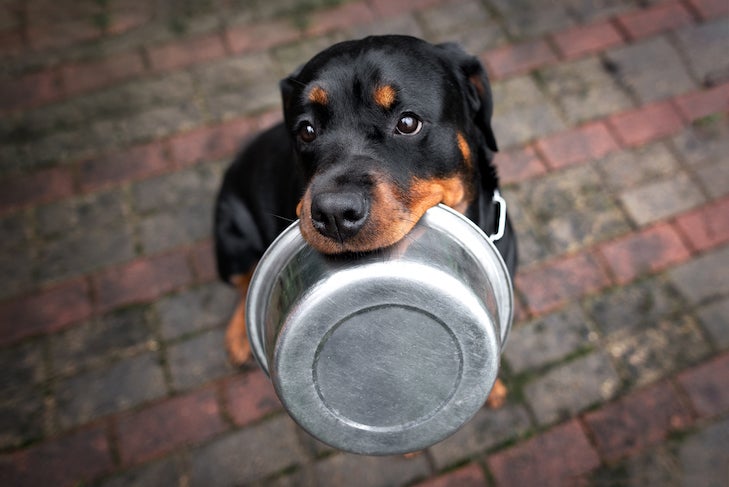Chocolate is toxic to dogs, and depending on the type and amount of chocolate consumed and the weight of your dog, it could cause a serious medical emergency. But what should you do if your dog ate chocolate?
If you know your dog has eaten chocolate, it’s important to monitor them for signs of toxicity. Learn how much is too much, which types of chocolate are the most dangerous, and what signs to look for that may signal your dog needs treatment.
Why Chocolate Is Toxic to Dogs
Chocolate contains both theobromine and caffeine. If your dog consumes food or drink with caffeine or theobromine in it, these chemicals can speed up the heart rate and stimulate their nervous systems.
The risk of your dog becoming sick from ingesting chocolate depends on the type and amount of chocolate consumed and your dog’s weight. The concentrations of these toxic substances vary among different types of chocolate. Here are a few types of chocolate listed in order of theobromine content:
- Cocoa powder (most toxic)
- Unsweetened baker’s chocolate
- Semisweet chocolate
- Dark chocolate
- Milk chocolate

Knowing how much and what kind of chocolate your dog ate can help you and your vet determine if you have an emergency. You can calculate your dog’s risk of toxicity with this chocolate toxicity calculator. In general, mild symptoms of chocolate toxicity occur when a dog consumes 20 mg of methylxanthines (including theobromine and caffeine) per kilogram of body weight. Cardiac symptoms of chocolate toxicity occur around 40 to 50 mg/kg, and seizures occur at dosages greater than 60 mg/kg.
In simpler terms, that means a very concerning dose of chocolate is approximately one ounce of milk chocolate per pound of body weight. Since an average milk chocolate bar may be around 1.55 ounces, consuming even one chocolate bar can have serious consequences, especially for small dogs. Eating a crumb of chocolate cake or a very small piece of a chocolate bar, on the other hand, probably won’t kill your dog, especially if it is a larger breed.
But dogs should never be fed chocolate as a treat. Instead, offer your pet a dog-safe alternative (like a treat featuring carob), which is just as tasty for canines!
What Are the Signs of Chocolate Poisoning?
What happens if a dog eats chocolate? They may experience chocolate poisoning.
Signs of chocolate poisoning usually appear within six to 12 hours after your dog has eaten it. Older dogs and dogs with heart conditions are more at risk of sudden death from chocolate poisoning. The symptoms, which may last up to 72 hours, include the following:
- Vomiting
- Diarrhea
- Restlessness
- Increased urination
- Tremors
- Elevated or abnormal heart rate
- Seizures
- Collapse and death
What to Do if Your Dog Eats Chocolate
If you believe your dog ate chocolate, call your veterinarian immediately or call the Pet Poison Helpline (855-213-6680) for advice. Note that if your vet is not open, some services provide live chat and video options to connect you with a vet. Based on your dog’s size and the amount and type of chocolate consumed, your veterinarian may recommend that you monitor your dog for the clinical signs listed above and call back if their condition worsens.

In other cases, the veterinarian may prefer you bring your dog into the clinic. If your pet consumed the chocolate less than two hours ago, your veterinarian may induce vomiting in your dog and give them several doses of activated charcoal, which works to move the toxins out of the body without being absorbed into the bloodstream. For more severe cases, veterinary intervention may be needed to provide supplemental medical treatment, such as medications or IV fluids, to resolve the effects of the poisoning. Dogs suffering from seizures may need to be monitored at the clinic overnight.
How to Prevent Your Dog from Eating Chocolate
To prevent your dog from sneaking chocolate, follow these tips:
Keep Chocolate Out of Reach
Make sure all chocolate items, including cocoa powder and hot chocolate mix, are stored where the dog cannot reach them, such as on a high shelf in a closed-door pantry. Remind your children and guests that chocolate should be kept out of the dog’s reach and not left out for dogs on countertops, tables, or in purses. Keep this in mind during the holidays, too, making sure to place trick-or-treat bags, Easter baskets, Valentine’s Day candy, Christmas stockings, and Hanukkah coins (gelt), for example, in a place where a dog cannot get to them.
Teach Them to Leave It
The command “leave it” is extremely effective in preventing dogs from eating something that falls onto the ground or is left within reach during a walk. It’s also a very easy command to teach.

Crate Train Your Dog
The safest way to ensure your dog doesn’t eat anything harmful while you’re not supervising them is to crate train them. Find a sturdy dog crate that is large enough for your dog to stand up and turn around in.
Make it a comfortable, safe place for them to retreat to when they want to be alone or when you can’t watch them. Offer items like a stuffed chew toy, favorite blanket, or treats to help them feel like the crate is their personal den.
This article is intended solely as general guidance, and does not constitute health or other professional advice. Individual situations and applicable laws vary by jurisdiction, and you are encouraged to obtain appropriate advice from qualified professionals in the applicable jurisdictions. We make no representations or warranties concerning any course of action taken by any person following or otherwise using the information offered or provided in this article, including any such information associated with and provided in connection with third-party products, and we will not be liable for any direct, indirect, consequential, special, exemplary or other damages that may result, including but not limited to economic loss, injury, illness or death.

